Don’t drop the ball on this one! Brace yourself as students put all their trust in you with Trust Falls. With no arms for bracing and eyes closed for intensity, your students can have fun falling (just a little) and relying on someone to catch them.
Trust Falls

Any Size
Grades 3-5
None
Development Goal
To understand the concept of trust and develop communication skills.
Before You Start
- Divide the group into partners, partners should be of similar body type.
- Briefly discuss the concept of âtrust.â
Have students practice everything before beginning the game. - Designate a signal to get into ready position and a signal to begin the dialogue.
Demonstrations:
- Ready Positions
- Faller: Feet together, legs stiff, arms folded across chest.
- Catcher: One leg back and straight, and one leg forward and bent, with both arms slightly bent in front of chest with palms facing outward.
Verbal Cues Before Fall:
1. Faller says “Spotter ready?”
2. Catcher says “Ready.”
3. Faller says “Falling.”
4. Catcher says “Fall on.”
- Choose a pair to demonstrate the entire sequence of ready positions, verbal cues, falling and catching and getting back to ready position.
Set Up
Pick a open space with enough room for the group and a softer ground, such as grass or carpet over blacktop.
How to Play
- Have partners stand in two lines facing each other. Have one side turn around.
- Give signal for both sides to get into ready positions.
- Signal for verbal cues.
- Students fall and get back to ready position.
- Let them go through cycle with the same roles three times and have them switch roles.
- Once they switch, go back to the step-by-step instructions.
Variations
- Form a circle of five students, standing shoulder to shoulder in the catcher ready position. Have one student in the center in the faller ready position. The student in the center allows their body to fall in any direction around the inside of the circle while the catchers gently support them.
- Have two groups of six students line up facing each other with their arms outstretched and interlaced. One student stands on a chair in ready position with his/her back to the two lines. Go through the verbal cues and fall back onto the interlaced arms. If you want to make it even more challenging, have the person falling stand on a table versus a chair.